Vatican Art Story | Location | Opening Hours Tickets | Authorisations
Art Story Sistine Chapel | Raphael | Caravaggio | da Vinci | Giotto | Titian | Veronese | Sculptures | Van Gogh |
The Titian “Madonna of San Niccolò dei Frari” or “Madonna and Child in Glory” at the Pinacoteca of the Vatican Museums in Rome
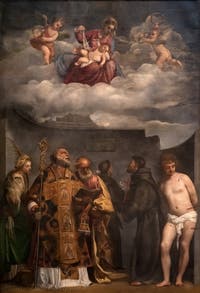
Madonna and Child
Titian (1488-1576) ““Madonna of San Niccolò dei Frari” or “Madonna and Child in Glory” with Saint Catherine, Saint Nicholas, Saint Peter, Saint Anthony of Padua, Saint Francis and Saint Sebastian”
Painting - Oil on wood transposed onto canvas (420 x 290 cm) 1533-1535Initially, the Madonna of the Frari by Titian was painted for the high altar of the small church of San Niccolò della Lattuga in Lido of Venice, also called San Niccolò des Frari.
A work that the Franciscan monks of San Niccolò wanted to offer to the Virgin after the end of a plague epidemic.
The brothers of San Niccolò had initially thought of entrusting the painting to Paris Bordone, then they changed their mind, and it was Titian who was chosen to execute it.
One can imagine that Titian devoted himself earnestly to this work because of the competition he managed to rule out.
Indeed, for painters of the time and for the most significant art critics, this Madonna of the Frari, now in the Vatican Pinacoteca, is considered one of Titian's greatest masterpieces.
Titian's “Madonna and Child in Glory”: living characters!
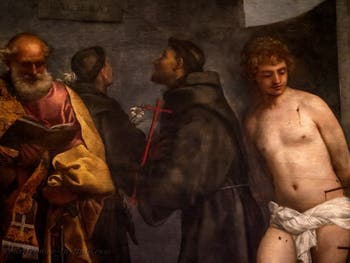
Madonna and Child The Venetian painter Pordenone, upon seeing this work by Titian and his Saint Sebastian, is said to have declared:
“I think that Titian used human flesh instead of paint to portray Saint Sebastian's naked body!”
Pordenone
Lodovico Dolce, a painting theorist, was in awe of the gold brocades on Saint Nicholas's tunic, showing the weave of the fabric with its folds varying according to the light and the reflections of the scene in a way that seemed real.
Giorgio Vasari, like Pordenone, admired Saint Sebastian by Titian, saying that his flesh seemed alive.
Madonna and Child Jesus in Titian's “Madonna of the Frari”
Initially, the monks of the Frari asked Titian to conduct a “Sacred Conversation” between the Madonna and the Saints, but they changed their minds, and the composition of the painting had to be changed.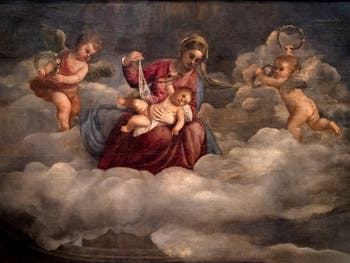
Madonna and Child To achieve it, Titian painted the Madonna and Child at the top to transform the scene into a miraculous appearance of the Madonna and the Child Jesus to the saints represented under her.
This painting, which can be admired today in the Vatican Gallery, was, unfortunately, the subject of a double sacrilege made by an idiot; there is no other word for it.
Indeed, the upper part of the original painting had a bezel painted the dove of the Holy Spirit, whose divine rays illuminate the Madonna and Jesus to allow the Saints to contemplate the mystery.
For the stupid reason of presenting the painting in the halls of the Vatican, since it should be hung next to Raphael's rectangular “Transfiguration”, there was no better way to cut the bezel with the Holy Spirit to “harmonize” the display between the two paintings!
This scope, despite numerous searches, has never been found.
In addition to changing the deeper meaning of the painting, this operation also had the effect of breaking the harmony and power of Titian's composition by now presenting Madonna's head almost against the upper edge: there is no longer enough space for this part of the scene to “breathe.”
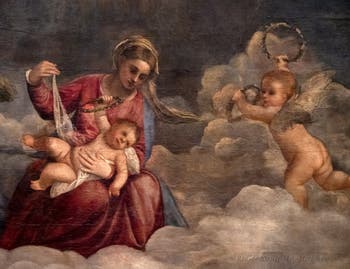
Madonna and Child We can still vaguely distinguish a few divine rays above the Virgin.
Mary and the Infant Jesus are on a bed of clouds, accompanied by two chubby cherubs holding wreaths of flowers.
Titian portrayed the Infant Jesus in his mother's arms as an average child who must be held firmly so that he does not fall while he wiggles his legs and kicks his mother.
The Virgin and Jesus look at the six saints below them, especially Saint Sebastian.
We will also notice the sweet face of the Virgin Mary, which reveals a certain tenderness towards these Saints.
The Six Saints of Titian's “Madonna of the Frari”
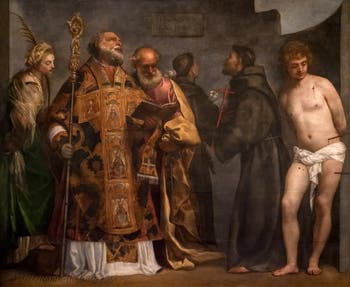
Madonna and Child The six saints represented are, from left to right, Saint Catherine of Alexandria, Saint Nicholas in bishop's clothes, Saint Peter, Saint Anthony, Saint Francis, and Saint Sebastian.
Titian portrayed them in the choir of an abandoned, roofless church.
Saint Sebastian is shown on the far right.
Titian particularly highlighted him so that he would become the central character of the group of saints.
First, the fact that he is naked while the others are all dressed makes him stand out strongly.
The saint’s nudity is also reinforced by his body's bright skin tones, which contrast with those of the dark clothes of the holy monks or the gold of the other saints.
Finally, the eyes of the Virgin and the Child Jesus are clearly directed towards Saint Sebastian.
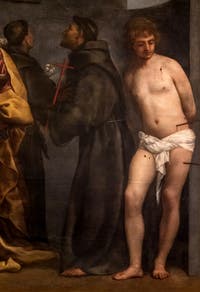
Madonna and Child Saint Sebastian is classically represented by Titian: attached to a pillar, arrows are planted in his body. In contrast, the expression on his face and the general attitude of his body seems foreign to his torment.
His face in a half-shadow is serene and meditative, with no trace of pain.
Saint Sebastian is also the only one whose face is turned towards the viewer, increasing his presence.
On the left, you can see Saint Catherine of Alexandria, pensive.
Titian represented her as full of grace and beauty with an elegant hairstyle marking her royal status and holding the palm of martyrdom in her hand.
Right next to her is an impressive and imposing Saint Nicolas, whose face is concentrated.
Saint Nicholas is highlighted by his height, the width of his bust, the richness and gold colour of his bishop's vestments, and his butt.
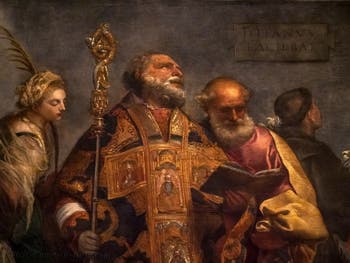
Madonna and Child Her head is turned back, her face turned to the sky to contemplate the Madonna and the Divine Child.
Some art critics believe that Titian was inspired by the Laocoon sculpture.
Like in the Laocoon, Titian’s Saint Nicholas has the same features and position of the head.
This is probable since we know that his friend Sansovino had made a copy of it and that Titian had a plaster cast of the Laocoon in his workshop.
Saint Peter, with a large yellow mantle and keys in one hand, is represented next to Saint Nicolas. He is reading the book that Saint Nicolas is holding.
Between Saint Peter and Saint Sebastian, the two patron saints of the Franciscan Order, Saint Francis and Saint Anthony, are dressed in dark burrs.
Recall that this painting was commissioned from Titian by monks of the Franciscan order and for a church in Lido dedicated to Saint Nicholas.
Art Story Sistine Chapel | Raphael | Caravaggio | da Vinci | Giotto | Titian | Veronese | Sculptures | Van Gogh |
Vatican Art Story | Location | Opening Hours Tickets | Authorisations
Back to Top of Page

